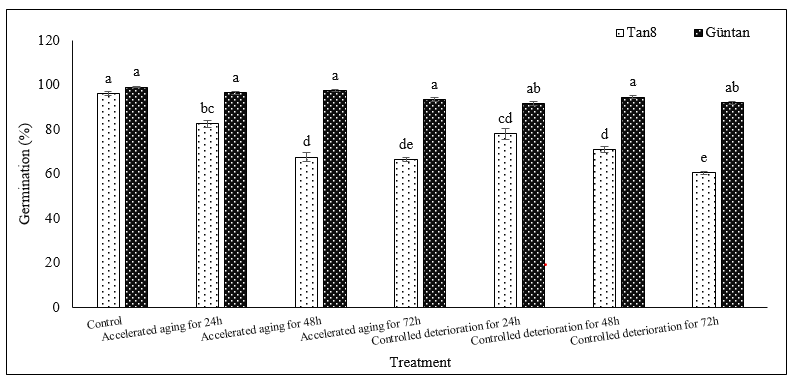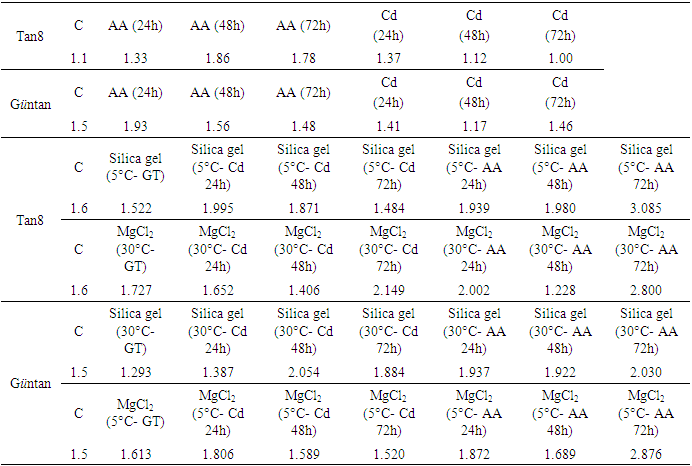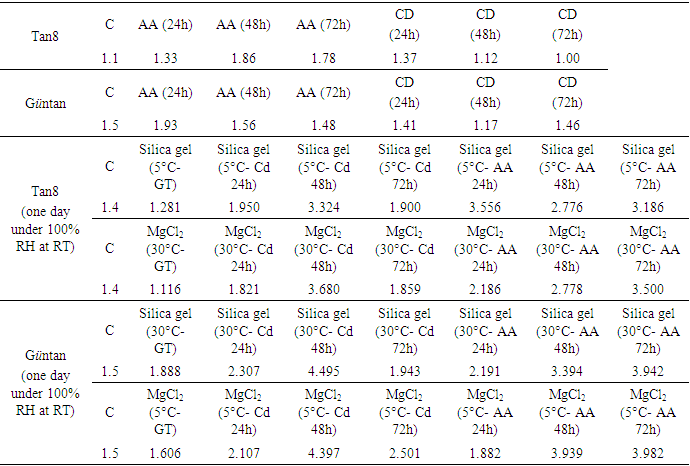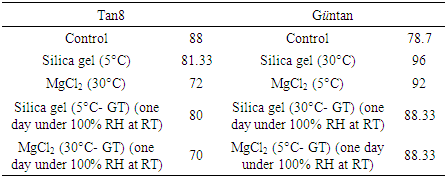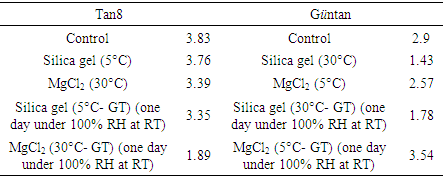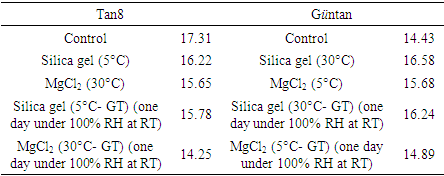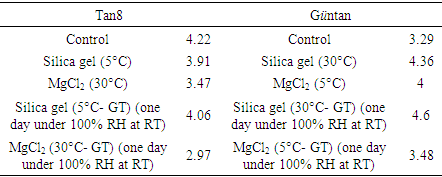-
Paper Information
- Paper Submission
-
Journal Information
- About This Journal
- Editorial Board
- Current Issue
- Archive
- Author Guidelines
- Contact Us
International Journal of Agriculture and Forestry
p-ISSN: 2165-882X e-ISSN: 2165-8846
2022; 12(2): 55-63
doi:10.5923/j.ijaf.20221202.03
Received: Sep. 1, 2022; Accepted: Sep. 19, 2022; Published: Sep. 23, 2022

Comparison of the Effects of Different Drying Chemicals and Temperatures on Onion (Allium cepa L.) Seed Vigour
Burcu Begüm Kenanoğlu1, Zahra Monemizadeh2
1Department of Horticulture, Agriculture Faculty, University of Uşak, Uşak, Turkey
2Department of Agronomy, University of Agricultural Sciences and Natural Resources, Gorgan, Iran
Correspondence to: Burcu Begüm Kenanoğlu, Department of Horticulture, Agriculture Faculty, University of Uşak, Uşak, Turkey.
| Email: |  |
Copyright © 2022 The Author(s). Published by Scientific & Academic Publishing.
This work is licensed under the Creative Commons Attribution International License (CC BY).
http://creativecommons.org/licenses/by/4.0/

Desiccant is a hygroscopic chemical that dries the surface of the seed. Silica is the most often used desiccant, and others include activated charcoal, bentonite, and zeolite. In addition, the relative humidity and temperature given to the environment by saturated salt solutions (NaCl, Silica gel, CaCl2, NaOH, MgCl2, KNO3) used in controlled conditions during seed drying have different effects on this process. The aim of this study was to understand the change in viability with the drying of the seed and the quality change with the dehumidification process applied at room conditions. In this context, accelerated aging, controlled deterioration, and EC tests were carried out. The maximum germination rate was attained in the control group, and the results of the controlled deterioration and accelerated aging tests were significant for the Tan8 variety, but not for the Güntan variety. After aging and deteriorating for a while, seed germination decreased, especially in the Tan8 variety. According to the results, the Tan8 variety was significantly affected by the temperature and the type of the desiccant. In general, the drying media with MgCl2 resulted in an earlier mean germination time for the controlled deterioration test after humidification. When the seedling emergence performance was evaluated, drying the seeds of the Tan8 variety more rapidly with MgCl2 negatively affected the results. For both varieties, the humidification group's longest root length was measured after drying with silica gel.
Keywords: Onion, Desiccant, Seed vigor, Seedling quality, Vigor tests
Cite this paper: Burcu Begüm Kenanoğlu, Zahra Monemizadeh, Comparison of the Effects of Different Drying Chemicals and Temperatures on Onion (Allium cepa L.) Seed Vigour, International Journal of Agriculture and Forestry, Vol. 12 No. 2, 2022, pp. 55-63. doi: 10.5923/j.ijaf.20221202.03.
Article Outline
1. Introduction
- Onion (Allium cepa L.) is one of the most important spices and commercial biennial vegetable crops on all continents. It is consumed as fresh onion and bulb onion mainly due to its high profitability in the cuisine, and antibacterial and curative values around the world [1]. The fundamental component of the production of agronomic and horticultural crops is using good quality and certified seeds to enhance productivity and to ensure a higher yield potential for achieving the desired goal. Many aspects determine seed quality, and one of the fundamental attributes is seed vigor which has been identified worldwide and perceived as the fast and uniform emergence of plants under a broad-ranging field conditions providing high plant performance for its association with field stand establishment and crop productivity and which has a pivotal role in the seed industry [2]. Onion seed quality is determined by environmental temperature and variation during seed production and development, seed position on the plant, timely and proper harvesting, procedures adopted for seed drying and storage, and seed priming techniques [3]. The main factors affecting storability are moisture content and storage temperature. Adverse conditions (high humidity at a high temperature) considerably result in seed deterioration during storage [4] and also accelerate the aging of the seed [2]. Arabidopsis thaliana [5], zinnia (Zinnia elegans), and lettuce (Lactuca sativa L.) [6] are susceptible to high humidity. There are several methods to acquire information on seed vigor that directly or indirectly determines the tolerance of seeds to certain conditions or predicts metabolic changes or activities during seed germination, such as new knowledge gained through biotechnology, molecular biology, and seedling imaging analysis [2]. Among them, the commonly used procedures, such as accelerated aging and controlled deterioration tests, are useful for many species due to their more cost-effectiveness, speed, and simplicity of operation [7].The term desiccation has received much attention worldwide in recent years, and is associated with low moisture contents. Although the moisture content of the seed after harvest varies according to the species, it is between 13-18% in most crops. The drying temperature needs to be lower as the seed's initial water content increases. After the water content is reduced to less than 10% by drying, the seed retains 50% or more of its original germination percentage, with some degree of tolerance. Therefore, metabolic activities occur during the seed desiccation phase. The permeability of cell membranes, seed viability, storage life, dormancy status and germination of dry seeds decrease as a result of oxidative stress or damage occurring in this process, and gene expression in enzyme synthesis [8]. Since warm air will negatively affect seeds' ability to germinate, seeds cannot be dried by being exposed to heated air. The alternative is to release the product's moisture into the surrounding air. The dryer can speed up the drying process by keeping the air's moisture content lower. Additionally, it eliminates weather unpredictability as a role in drying operations. Sun drying (natural drying), forced air drying (mechanical drying), and desiccants (chemical drying) are the ways used to dry seeds. The method to be applied varies according to the species. Especially chemical drying results in minimal mechanical or physiological damage to the seed. The desiccant that is used most frequently is silica, while additional options include activated charcoal, bentonite, and zeolite. Moreover, saturated salt solutions (NaCl, Silica gel, CaCl2, NaOH, MgCl2, KNO3) applied under controlled conditions during seed drying have a varied impact on the relative humidity and temperature of the environment. Also, pre-germination treatments using inorganic salt solutions, such as CaCl2 [9], MgSO4 [10], NaCl [11], and MgCl2 [12], have beneficial properties on limited seeds. The gravimetric method was used to calculate the sorption isotherm curves of a native cork at 25, 40, and 60°C. Six saturated salt solutions (KOH, MgCl2, K2CO3, NaNO3, KCl, and BaCl2) were used in this approach, and it was shown that the MgCl2 salt produced lower relative humidity than the others [13].Onion seeds are difficult to store in the long term because their viability, germinability, and vigor quickly deteriorate. The goal of this study was to understand how the seed's viability changed as a result of drying and to articulate how the dehumidification procedure used in the seed's environment after drying affected germination and emergence quality. The effects of different drying chemicals on the seed viability of onion cultivars, which are widely used in Turkey, were investigated at different application temperatures.
2. Materials and Methods
- This study was carried out in May/ June 2022 in the seed research laboratory of the Department of Horticulture, Agriculture Faculty, Uşak University, Turkey. The ‘Tan8’ and ‘Güntan’ varieties, the two commercial varieties of onion (Allium cepa L.), were purchased from Agraton seed company in Turkey and used in the experiments. The seeds (8–9% moisture content) were kept at 4 ± 1°C in a refrigerator until starting the experiments. Moisture content (%), germination test (%), controlled deterioration, accelerated aging test, seedling emergence test (%) and electrical conductivity test (EC) (μscm-1g-1) were performed for these two onion varieties. Also, we used different desiccants (silica gel and Magnesium chloride (MgCl2)) at 5°C and 30°C for three days for allowing the seeds to dry either rapidly or slowly.1. Seed Moisture Content (SMC) For measuring the moisture content of the seeds, 1 gram of 2 duplicated onion seeds were weighed, dried in an oven at 103°C for 17 hours, and then placed in a desiccator for 20 minutes to cool the seeds. SMC was calculated as in Equation (1) [14]
 | (1) |
 | (2) |
 | (3) |
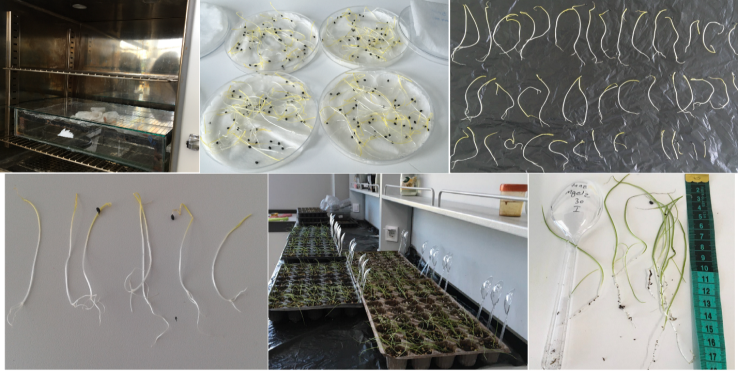 | Figure 1. Seed germination and seedling emergence experiment process |
|
3. Results and Discussion
3.1. Effect of Controlled Deterioration and Accelerated Aging Tests on Germination in Onion Seeds Varieties
- With the studies carried out, it was concluded that the high relative humidity between the seed coat and the surrounding air automatically increased the seed moisture. If the moisture condition of the seed is higher than the humidity in the air, the seed will lose water and become drier. If the humidity of the seed is less than the humidity of the air, the seed will receive moisture. The absorption or desorption of water continues until the water potential of the seed and the surrounding air are balanced. This condition in the seed is called equilibrium moisture content. Knowing the moisture status of seeds is very important for seed viability because seed moisture content is correlated with the rate at which seeds lose viability [21]. Vijay et al. investigated the effects of four drying methods using silica gel, lithium chloride-saturated salt solution, concentrated sulfuric acid, and desiccants on different physiological and biochemical properties of sorghum genotypes CSH 18 and CSV 18 [22], and concluded that while the faster drying rate was observed in acid and silica gel, the desiccant and saturated salt solution of lithium chloride showed slower drying rate than acid and silica gel. This study evaluated the effect of controlled deterioration and accelerated aging tests with different duration on the seed germination of two onion varieties. According to our results of ANOVA analysis, the effect of different treatments and duration on the germination percentage of the onion varieties was significant (P ≤0.01) (Table 1). The seed moisture content of the onion varieties was between 8-9% (Table 2). The results of the present study showed that there was variation in responses to the controlled deterioration and accelerated aging tests between the onion varieties (Fig. 2). The controlled deterioration and accelerated aging tests were not significant on the Güntan variety, whereas they were significant on the Tan8 variety. The highest germination percentage was achieved in control conditions (Fig. 2). Seed germination decreased with aging and deteriorating duration, especially in the Tan8 variety (Fig. 2).
|
|
 | Figure 3. Normal and Abnormal seedling percentage (%) |
3.2. Effect of Different Desiccants on Germination in Onion Seeds Varieties
- The obtained results indicated that the effect of different desiccants and their treatment temperatures on germination was significant in the tan8 variety, that the highest germination percentage was achieved in control conditions, and that different desiccants and duration were not, however, significant in the Güntan variety (Fig. 3). The moisture of the control group decreased by 2-4% with dryers in the Tan 8 variety and by 1-3.5% in the Güntan variety (Table 3). Vodouhe (2008) [23] reported similar results using silica gel and found the lowest moisture content (3.6 to 4.6%) in Citrullus lunatus, (3.3 to 4.3%) in Cucumeropsis edulis, and (4.6 to 7%) in Lagenaria siceraria seeds by drying three species of Egusi seeds. The electrical conductivity test, which measures the quantity of electrolytes leached out of the seed during imbibition, is a significant indicator of seed quality that has a negative relationship with seed germination [24]. In our study, the EC values varied. The EC results of the Tan 8 variety decreased as a result of drying, while the values of the Güntan variety increased (Table 3). The electrical conductivity of the seed leachate was found to be negatively related to seed viability and vigor. In the current study, the onion seeds preserved with zeolite beads had considerably lower electrical conductivity (0.723 dSm-1) than those preserved with bentonite granules (0.778 dSm-1), charcoal granules (0.780 dSm-1) or the control [25]. Several studies evaluated the effect of seed ageing on electrolyte leakage, and found that as the ageing period increased, seed leachate of conductivity increased in muskmelon seeds [26] and tomato seeds [26]. According to [27] Penaloza and Eira (1993), this could be the outcome of membrane repair through the hydration stage in tomato seeds.
|
|
|
|
3.3. Effect of Different Desiccants on Germination in Onion Seeds Varieties under One Day in 100% Relative Humidity at Room Temperature (RT)
- After drying the seeds of the cultivars at different temperatures with different dryers, they were kept at room temperature for 1 day in 100% relative humidity for moisture balance. According to their initial moisture, the seeds were dried at a rate of 1-4%, and there was an increase in moisture of approximately 10%. However, the EC values increased due to the mobility in the seed membrane (Table 7).
|
|
|
|
|
|
4. Conclusions
- There are various forms of drying methods, such as sun drying, forced air drying, modified solar drying [30], and desiccant drying [31], which have been used for drying seeds to reduce seed moisture content. Since seed is a material used for regeneration purposes, it must be dried in a manner that does not affect its germination and viability during storage. Desiccant drying in a closed container is often suggested as a low-technology method to reduce the moisture content of seed germplasm. Suitable desiccants include silica gel (sodium silicate), lithium chloride, calcium chloride, molecular sieve, charcoal, and rice that have been widely used on agricultural seeds with an appreciable success [32]. The EC value was measured to be lower in the seeds dried with magnesium; therefore, the highest germination and emergence performance was obtained from the seeds in this group in general. In the vigor tests, the effects of the drying chemicals on the seed varied according to the moisture difference to which the seed was exposed. According to the results obtained in general, magnesium chloride provided a controlled moisture reduction, which showed differences in seed viability according to the variety. However, seedling quality of seed groups dried with silica gel, which is one of the most common dryers, was better. In this respect, magnesium salt, which has a feature close to the drying efficiency of silica gel, can also be used.
References
| [1] | Selvaraj, S., 1976, Onion: Queen of the kitchen. Kisan World, 3(12), 32-34. |
| [2] | Marcos Filho, J., 2015, Seed vigor testing: an overview of the past, present and future perspective. Scientia agricola, 72, 363-374. |
| [3] | Dorna, H., Jarosz, M., Szopinska, D., Szulc, I., and Rosinska, A., 2013, Germination, vigour and health of primed Allium cepa L. seeds after storage. Acta Scientiarum Polonorum Hortorum Cultus, 12(4), 43-58. |
| [4] | Copeland, L.O. and McDonald, M.B., 2001, In Principles of Seed Science and Technology, 4th Edition, Kluwer Academic Publishers, Boston. |
| [5] | Takimoto, K., Yaguchi, H. and Miyakoshi, J., 2001, Extremely low-frequency magnetic fields suppress the reduction of germination rate of Arabidopsis thaliana seeds kept in saturated humidity. Bioscience, Biotechnology and Biochemistry, 65, 2552–2554. |
| [6] | Doijode, S.D., 2001, In Seed Storage of Horticultural Crops, Food Products Press, New York. |
| [7] | Khan, M. M., Iqbal, M. J., Abbas, M., Raza, H., Waseem, R., and Ali, A. R. S. H. A. D., 2004, Loss of vigour and viability in aged onion (Allium cepa L.) seeds. Int. J. Agric. Biol, 6(4), 701-711. |
| [8] | Borisjuk, L. and Rolletschek, H., 2009, The oxygen status of the developing seed. New Phytol. 182, 17–30. |
| [9] | Abdolahi, M., Andelibi, B., Zangani, E., Shekari, F., and Jamaati-E-Somarin, S., 2012, Effect of accelerated aging andpriming on seed germination of rapeseed (Brassica napus L.) cultivars. Int. Res. J. Appl. Basic Sci., 3, 499–508. |
| [10] | Carrozzi, L.E., Creus, C.M., Barassi, C.A., Monterubbianesi, G., Di Benedetto, A., 2012, Reparation of aged lettuce (Lactuca sativa) seeds by osmotic priming and Azospirillum brasilense inoculation. Botany, 90, 1093–1102. |
| [11] | Khan, H.A., Ayub, C., Pervez, M.A., Bilal, R.M., Shahid, M., and Zaif, K., 2009, Effect of seed priming with NaCl onsalinity tolerance of hot pepper (Capsicum annuum L.) at seedling stage. Soil Environ., 28, 81–87. |
| [12] | Batool, A., Ziaf, K., and Amjad, M., 2015, Effect of halo-priming on germination and vigor index of cabbage (Brassica oleracea var. capitata). J. Environ. Agric. Sci., 2. |
| [13] | Abdulla, G., B., Abdelhamid and Allaf, K., 2009, Impact of Instant Controlled Pressure Drop Treatment on Moisture Adsorption Isotherm of Cork Granules', Drying Technology. 27:2, 237 — 247. |
| [14] | ISTA, 1993, International rules for seed testing. Seed Science and Technology. (suppl.) 21, 1–288. |
| [15] | ISTA, 2005, International Rules for Seed Testing International Seed Testing Association. Bassersdorf, Switzerland. |
| [16] | Demir, I., Günay, A., 1994, Tohum kalitesindeki farklılıkların hıyar tohumlarının çimlenme, çıkış ve sonrası fide gelişimine etkisi, Bahçe Dergisi, 23(1-2), 27-32s. |
| [17] | Powell, A.A., 1995, The controlled deterioration test. p. 73-87. In: van der Venter, H.A., ed. Seed Vigour Testing Seminar. The International Seed Testing Association, Kopenhagen, Denmark. |
| [18] | Nascımento, W.M., Freıtas, R.A., Gomes E.M.L., and Soares, A.S., 2007, Metodologia para o teste de envelhecimento acelerado em sementes de ervi lha. Horticultura Brasileira 25: 205-209. |
| [19] | ISTA, 2003, International rules for seed testing. Seed Science and Technology. 27: Supplement. |
| [20] | Agarwal, P.K., and Dadlani, M., l992, Tetrazolium test for seed viability and vigour techniques. In: P.K. Agrawal and M Dadlani (eds.). Seed Science and Technology (2nd Edition), pp. 84 - 89, South Asian Publisher, New Delhi. |
| [21] | Probert, R.J., 2003, Seed viability under ambient conditions, and the importance of drying. In Seed Conservation: Turning Science into Practice, (eds. R.D. Smith, J.B. Dickie, S.H. Linington, H.W. Pritchard, R.J. Probert) Royal Botanic Gardens Kew, Richmond, UK. 2003; 337-365. |
| [22] | Vijay, M. K., Pandey, S., Pandey, C. D., and Jeshima, Y., 2015, Impact of drying methods on the seed quality of sorghum (Sorghum bicolor (L.) Moench), African Journal of Agricultural Research, 10(16), 1898-1903. |
| [23] | Vodouhe, R.S., Achigan, Dako G.E., Dulloo, M.E. and Kouke, A., 2008, Effects ofsilica gel, sun drying and storage conditions on viability of egusiseeds (Cucurbitaceae). Plant Genetic Resources Newsletter, 153, March 2008, pp. 36-42. |
| [24] | Hibbard, R. P., and J. V. Miller, 1928, Biochemical studies on seed viability measurements of conductance and reduction. Plant Physiol., 3: 335-352. |
| [25] | Ninganna, J.S. Hilli, and B.S., Vyakaranahal, 2018, Influence of Desiccants on Quality of Onion Seeds during Ultra Dry Storage. International Journal of Current Microbiology and Applied Sciences ISSN: 2319-7706 Volume 7 Number 12. |
| [26] | Pesis, E. and J, N. Timothy, 1983, Viability, vigour and electrolyte leakage of muskmelon seeds subjected to accelerated ageing. Horti. Sci., 18: 242- 244. |
| [27] | Penaloza, A. P. S., and M. T. S., Eira, 1993, Hydration dehydration treatments on tomato seeds (Lycopersicon esculentum (Mill)) Seed Sci. Technol., 21: 309 - 316. |
| [28] | Ferguson, J.M, D.M. Tekrony and D.E. Egli, 1990, Changes during early seed and axes deterioration: 11. Lipids. Crop Sci., 30: 179–82. |
| [29] | Nassari, P.J., Keshavulu, K., Manohar, R., Reddy, K.C.S., and Raheem, A., 2014, Post harvest dryıng of tomato (Lycopersicon esculentum mill) seeds to ultra low moısture safe for storage usıng desıccant (zeolıte) beads and theır effects on seed qualıty, American Journal of Research Communication, 2(4), 74-83. |
| [30] | Brooker, D.B., Bakker-Arkema, F.W., and Hall, C.W., 1992, Drying and storage of grains and oilseeds. Springer Science and Business Media; 1992 Jan 31. |
| [31] | Hay, F.R., Probert, R.J., 2011, Collecting and handling seeds in the field. In Collecting Plant Genetic Diversity: Technical Guidelines – 2011 Update, (eds. L. Guarino, V. Ramanatha Rao and E. Goldberg); 2012 Available: http://cropgenebank.sgrp.cgiar.or/index.php?option=com_content&view=ar ticle&id=65 (accessed April 2012). |
| [32] | Rao, N.K., Hanson, J., Dulloo, M., Ghosh, K., Nowell, D., and Larinde, M., 1998, Manual of seed handling in genebanks. Handbooks for Genebanks No. 8. Biodiversity International, Rome, Italy; 1998. Recalcitrant Seeds, 12 – 15 October, Kuala Lumpur, Malaysia. (Forest Research Institute of Malaysia) Kepong, Malaysia. 2006; 227–234. |
 Abstract
Abstract Reference
Reference Full-Text PDF
Full-Text PDF Full-text HTML
Full-text HTML


